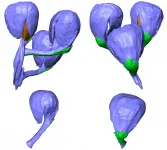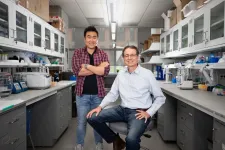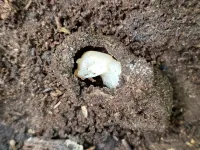Overdose-associated cardiac arrests during COVID-19 pandemic
2021-05-26
(Press-News.org) What The Study Did: This study included data from more than 11,000 emergency medical services (EMS) agencies in 49 states to describe racial/ethnic, social and geographic changes in EMS-observed overdose-associated cardiac arrests during the COVID-19 pandemic through 2020 in the United States.
Authors: Joseph Friedman, M.P.H., of the University of California, Los Angeles, is the corresponding author.
To access the embargoed study: Visit our For The Media website at this link https://media.jamanetwork.com/
(10.1001/jamapsychiatry.2021.0967)
Editor's Note: The article includes funding/support disclosures. Please see the article for additional information, including other authors, author contributions and affiliations, conflict of interest and financial disclosures, and funding and support.
INFORMATION:
Media advisory: The full study is linked to this news release.
Embed this link to provide your readers free access to the full-text article This link will be live at the embargo time https://jamanetwork.com/journals/jamapsychiatry/fullarticle/10.1001/jamapsychiatry.2021.0967?guestAccessKey=43e7b829-953f-481e-a570-117bbece7b07&utm_source=For_The_Media&utm_medium=referral&utm_campaign=ftm_links&utm_content=tfl&utm_term=052621
ELSE PRESS RELEASES FROM THIS DATE:
2021-05-26
What The Study Did: Researchers conducted a review of studies examining the frequency and variety of persistent symptoms after COVID-19 infection.
Authors: Steven N. Goodman, M.D., M.H.S., Ph.D., of Stanford University in Stanford, California, is the corresponding author.
To access the embargoed study: Visit our For The Media website at this link https://media.jamanetwork.com/
(doi:10.1001/jamanetworkopen.2021.11417)
Editor's Note: Please see the article for additional information, including other authors, author contributions and affiliations, conflict of interest and financial disclosures, and funding and support.
INFORMATION:
Media ...
2021-05-26
What explains how often people travel to a particular place? Your intuition might suggest that distance is a key factor, but empirical evidence can help urban studies researchers answer the question more definitively.
A new paper by an MIT team, drawing on global data, finds that people visit places more frequently when they have to travel shorter distances to get there.
"What we have found is that there is a very clear inverse relationship between how far you go and how frequently you go there," says Paolo Santi, a research scientist at the Senseable City Lab at MIT and a co-author of the new paper. "You only seldom go to faraway places, and usually you tend to visit places close to you more often. It tells us how we organize our lives."
By examining cellphone data ...
2021-05-26
What The Study Did: Researchers analyzed each state's department of health website for accessibility and usability challenges. Findings suggest state health department COVID-19 vaccine website accessibility and usability challenges create frustration, may promote health disparities and contribute to overall ineffective and inequitable distribution.
Authors: Raj M. Ratwani, Ph.D., of the Medstar Health National Center for Human Factors in Healthcare in Washington, D.C., is the corresponding author.
To access the embargoed study: Visit our For The Media website at this link https://media.jamanetwork.com/
(doi:10.1001/jamanetworkopen.2021.14861)
Editor's ...
2021-05-26
Seeing, hearing, thinking, daydreaming -- doing anything at all, in fact -- activates neurons in the brain. But for people predisposed to developing brain tumors, the ordinary buzzing of their brains could be a problem. A study by researchers at Washington University School of Medicine in St. Louis and Stanford University School of Medicine shows that the normal day-to-day activity of neurons can drive the formation and growth of brain tumors.
The researchers studied mice genetically prone to developing tumors of their optic nerves, the bundle of neurons that carries ...
2021-05-26
What The Study Did: Researchers quantified the added burden of fatal opioid overdoses occurring in Ontario, Canada, during the first six months of the COVID-19 pandemic.
Authors: Tara Gomes, Ph.D., of the Keenan Research Centre of the Li Ka Shing Knowledge Institute, St. Michael's Hospital in Toronto, is the corresponding author.
To access the embargoed study: Visit our For The Media website at this link https://media.jamanetwork.com/
(doi:10.1001/jamanetworkopen.2021.12865)
Editor's Note: The article includes conflict of interest and funding support disclosures. ...
2021-05-26
What The Study Did: Researchers compared reporting practices for race, sex and socioeconomic status in randomized clinical trials published in general medical journals in 2015 with those published in 2019.
Authors: Asad Siddiqui, M.D., of the Hospital for Sick Children in Toronto, is the corresponding author.
To access the embargoed study: Visit our For The Media website at this link https://media.jamanetwork.com/
(doi:10.1001/jamanetworkopen.2021.11516)
Editor's Note: Please see the article for additional information, including other authors, author contributions and affiliations, conflict of interest and financial disclosures, and funding and support.
INFORMATION:
Media advisory: The full study is linked to this news ...
2021-05-26
Flowering plants (angiosperms) dominate most terrestrial ecosystems, providing the bulk of human food. However, their origin has been a mystery since the earliest days of evolutionary thought.
Angiosperm flowers are hugely diverse. The key to clarifying the origin of flowers and how angiosperms might be related to other kinds of plants is understanding the evolution of the parts of the flower, especially angiosperm seeds and the fruits in which the seeds develop.
Fossil seed-bearing structures preserved in a newly discovered Early Cretaceous silicified peat in Inner Mongolia, China, provide a partial answer to the origin of flowering plants, according to a study led by Prof. SHI Gongle from the Nanjing ...
2021-05-26
LEXINGTON, Ky. (May 26, 2021) - Using novel imaging methods for studying brain metabolism, University of Kentucky researchers have identified the reservoir for a necessary sugar in the brain. Glycogen serves as a storage depot for the sugar glucose. The laboratories of Ramon Sun, Ph.D., assistant professor of neuroscience, Markey Cancer Center at the University of Kentucky College of Medicine, and Matthew Gentry, Ph.D., professor of molecular and cellular biochemistry and director of the Lafora Epilepsy Cure Initiative at the University of Kentucky College ...
2021-05-26
Berkeley -- The lifestyle of the horned passalus beetle, commonly known as the bessbug or betsy beetle, might seem downright disgusting to the average human: Not only does this shiny black beetle eat its own poop, known as frass, but it uses its feces to line the walls of its living space and to help build protective chambers around its developing young.
Gross as it may seem, a new study suggests that this beetle's frass habits are actually part of a clever strategy for protecting the insect's health -- and could help inform human medicine, too.
Researchers at the University of California, Berkeley, have discovered that the frass of the horned passalus beetle is teeming with antibiotic and antifungal chemicals similar to the ones that humans use to ward off bacterial and ...
2021-05-26
In a new study published online in spring 2021 and in the July issue of the journal Contraception, University of Chicago Medicine investigators and colleagues interviewed primary care providers in Illinois about their interest in providing medication abortion care and found that lifting FDA restrictions on mifepristone to allow pharmacy dispensing could normalize medication abortion, facilitate its use in primary care facilities, and address disparities in reproductive health access.
"Mifepristone is used in combination with misoprostol to end early pregnancies, during the first trimester," ...
LAST 30 PRESS RELEASES:
[Press-News.org] Overdose-associated cardiac arrests during COVID-19 pandemic


